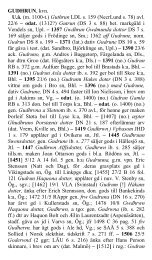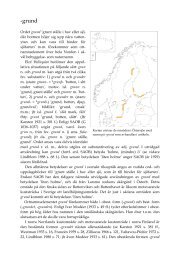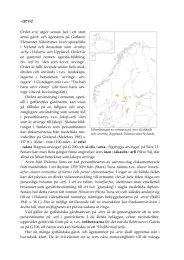NORNA-RAPPORTER 88 Binamn. Uppkomst, bildning, terminologi ...
NORNA-RAPPORTER 88 Binamn. Uppkomst, bildning, terminologi ...
NORNA-RAPPORTER 88 Binamn. Uppkomst, bildning, terminologi ...
You also want an ePaper? Increase the reach of your titles
YUMPU automatically turns print PDFs into web optimized ePapers that Google loves.
42 Silvio Brendler<br />
(c) The praxeological principle (bynaming after a/the socially significant<br />
activity of the bynamed person) applies to bynames of occupation and bynames<br />
of office.<br />
(d) The ethological principle (bynaming after behaviour characterising<br />
the bynamed person) applies to nicknames characterising the behaviour<br />
(e.g. a habit, vice, virtue) of the bynamed person.<br />
(e) The phenomenological principle (bynaming after [the perception of]<br />
appearance) applies to bynames characterising the appearance (e.g. colour,<br />
size, age, clothes) of the bynamed person.<br />
(f) The horological principle (bynaming after a period or moment to<br />
which the bynamed person is related in a special way) applies to bynames<br />
after, e.g. the birthday, (in the case of foundlings) the day/time of discovery.<br />
(2) description vs. byname,<br />
(3) occasional vs. usual byname,<br />
(4) non-hereditary vs. hereditary byname,<br />
(5) production vs. reproduction of bynames,<br />
(6) monogenesis vs. polygenesis of bynames,<br />
(7) self-designation vs. designation by others (this is, e.g., about the attitude of<br />
the byname giver to the bynamed person: affection, sympathy, neutrality, antipathy,<br />
aversion, animosity).<br />
Thirdly, aspects of byname use, including:<br />
(1) referential, metareferential and hypostatical use of bynames, with<br />
(a) referential use being found when bynames occur in normal use, i.e.,<br />
when they refer to someone, e.g. von hayn in «der erliche man Er heinrich<br />
von hayn Thumherre der kirchin ſente marian zcu Iſenach» [the honourable<br />
man Sir Heinrich von Hayn, canon of St Mary’s church in Eisenach] (EU p.<br />
279, ll. 21–23), agkirmans in «vom eyme hoffe heinrichs agkirmans des<br />
ſmedis» [of a hide of Heinrich Agkirman the smith] (EU, p. 280, ll. 45–46),<br />
ſlegels in «von eyme hoffe Cort ſlegels» [of a hide of Cort Slegel] (EU, p.<br />
280, l. 49),<br />
(b) metareferential use being found when the reference of bynames is being<br />
established, i.e. when bynames are introduced by phrases that serve as<br />
markers of metareferential use (underlined in the below examples) such as<br />
called and (by)named. Bynames do not yet refer to anyone in metareferential<br />
use, e.g. zcegenfleyß in «Cort vnd lodewig lipliche gebrudere genant<br />
zcegenfleyß» ‘Cort and Lodewig brothers german called Zcegenfleyß’ (EU,<br />
p. 279, ll. 11–12), Styrrer in «Heinrich genant Styrrer» ‘Heinrich called<br />
Styrrer’ (EU, p. 279, ll. 14–15), müczhin in «Dithart geheißin müczhin»<br />
‘Dithart named Müczhin’ (EU, p. 279, l. 18),<br />
(c) hypostatical use being found when bynames occur in hypostasis. They<br />
do not refer to anyone in this type of use, e.g. müczhin in «No definite interpretation<br />
of the byname müczhin without more written evidence», Agkirman

















